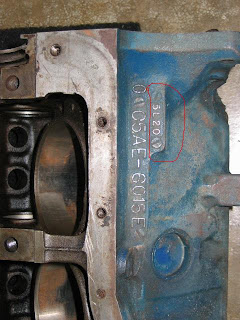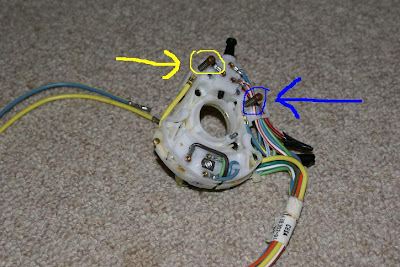This is the wiring diagram for the gauges on a 66 or a 65 that has either the GT (Performance/ Image Option) package or the Interior Decor Group, a.k.a. Pony Interior. If you click on the diagram, you will be able to see all of it, instead of just the left side. What I'm dealing with here will just be the water temp, fuel and oil pressure gauges. The ammeter gauge is a free-standing, independent system that has absolutely nothing to do with the other three gauges. The gauges on your car make up a system that supplies you with some very useful information when it is working correctly, and is a very simple system to understand and repair. What you have is a black wire with a green stripe on it coming from the back of the ignition switch going to the instrument cluster voltage regulator. The ICVR takes the 12V from the switch and, by means of thermally actuated contact points, knocks the voltage down to about 6 volts. The reason that Ford did it like this was because they had all of these perfectly good gauges of a proven level of reliability that were originally intended for a car with a 6V electrical system, and, rather than redesign and manufacture all new stuff, they just used a voltage regulator in the system. Ok, now that we have gotten that out of the way, you still have that black wire with the green stripe going from the ignition switch to the ICVR. On the other end of the ICVR you have a wire, still black/green that splits off to the three gauges. That wire plugs onto the what is the driver's side of the gauges when they are mounted in the dash. This wire brings power to the gauges. On the fuel gauge there will be a yellow wire with a white stripe that goes to the fuel sending unit in the gas tank. On the water temp gauge there will be a red wire with a white stripe that goes to the water temp sending unit, located towards the front of the intake manifold on a V8 and towards the rear of the cylinder head on a 6cyl. There will be a white wire with a red stripe going to the oil pressure sending unit, down near the oil filter. The wires going to the sending units work as a ground, with the sending unit itself determining how 'good' of a ground the gauge is getting.
If all three gauges are acting stupid on you, the problem is either the ICVR or the wire bringing the power to it. There is a dash to chassis ground wire that is hooked to the mounting screw of the ICVR, but that is what makes your dash lights and stuff go goofy on you. It doesn't have anything to do with the gauges.
If one or two of the gauges seem to be functioning normally and only one or two of them is having trouble, then the problem is almost always either the sending unit, the wire going to the sending unit, or the wire going from the ICVR to the gauge. Once in a blue moon it will actually be the gauge itself, but that happens so seldom that it really isn't even worth mentioning.
If the gas gauge is the one acting goofy the first thing that you want to do is to unplug the wire from the sending unit and, with the key in the 'On' position, ground that wire out to a suitable place on the car that isn't insulated from the rest of the car. The leaf spring shackles, for example, are in a handy location, but are completely insulated by the bushings. If the gauge pegs to full, the problem is inside the tank. The problem inside the tank is, far more often than not, the float isn't floating anymore. The brass floats cost like 5 bucks, whereas, a Ford sending unit costs nearly two hundred, and the repops cost about fifty and normally don't work. If the gauge does not peg to full, then the problem is either the wire going to the sending unit or the wire coming from the ICVR to the gauge.
If the water temp gauge is the one acting funny, again, ground the wire out somewhere and see if the gauge pegs. If yes, replace the sending unit. They also are cheap. If no, it's probably the wire going to the sending unit. People have the annoying tendency to cut that wire and then strip back both ends and tie the two ends back together. Don't do that. A brand new engine gauge feed only costs about twenty bucks, and you'll have brand new stuff that will work reliably for many years to come. If money's a bit tight, use some proper connectors of the male/female plug-in variety and wrap that to insulate it. All of what I just said about the water temp gauge is also true about the oil pressure gauge.
This isn't complicated. You can do this, and you can do it right.









































